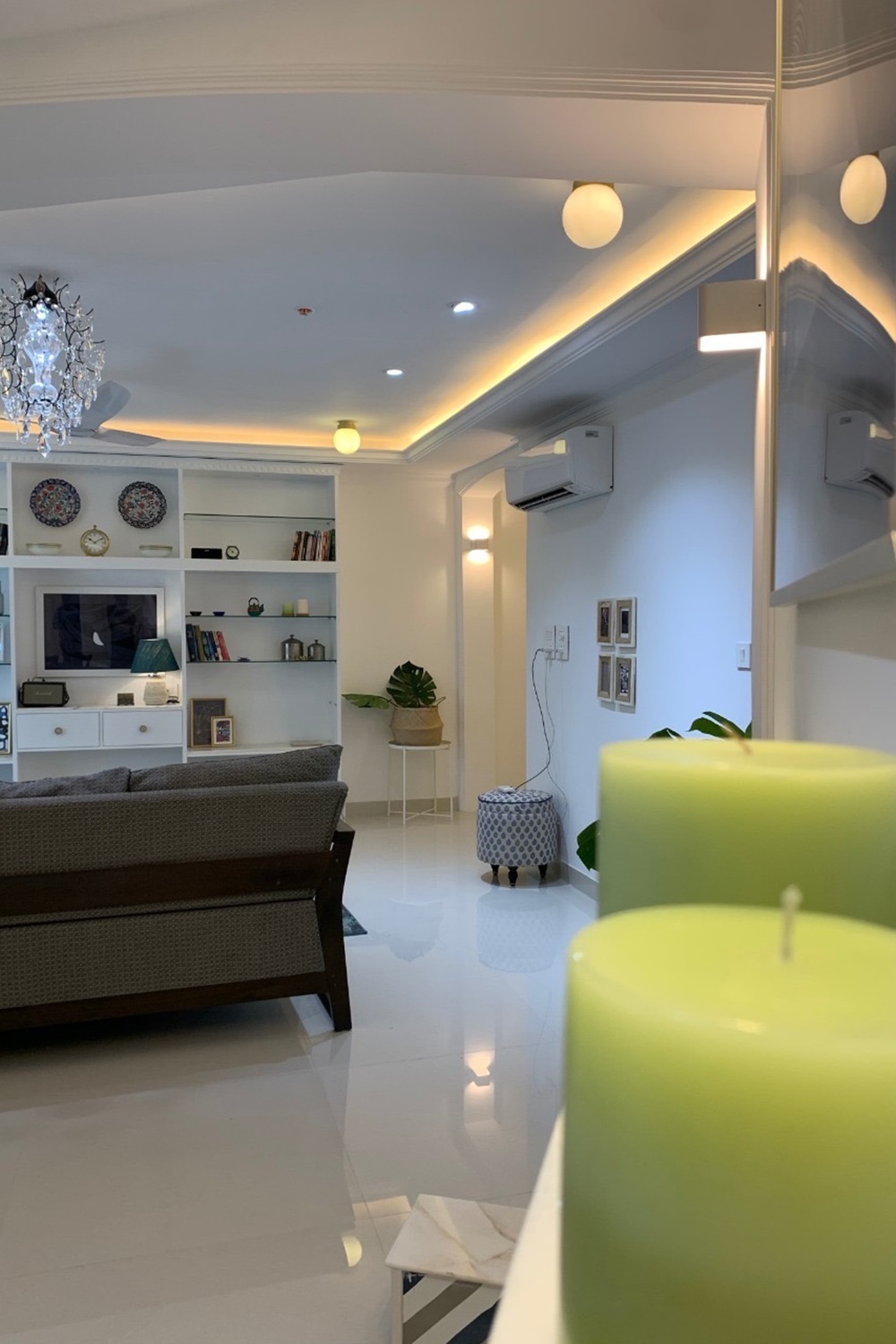
False ceiling.
A false ceiling in the living room is an architectural element that enhances both the aesthetic and functional qualities of the space. Also known as a drop ceiling, suspended ceiling, or secondary ceiling, it is installed below the original ceiling to create a layered effect, offering a stylish, modern, and elegant look. False ceilings are a popular choice in living rooms due to their versatility, allowing for creative designs, lighting integration, and practical benefits such as soundproofing and insulation.
Key Elements of a False Ceiling:
1. Design Styles:
- Contemporary: Clean lines and geometric patterns define contemporary false ceiling designs. These often feature sleek materials and minimalist detailing, with a focus on enhancing lighting.
- Traditional: More intricate designs, often with ornate moldings, detailed borders, or classical motifs, give the false ceiling a traditional and luxurious feel.
- Modern: Modern false ceilings emphasize creative shapes, hidden lighting, and sleek finishes, often using bold and innovative designs to create a statement piece.
- Rustic/Industrial: Exposed beams or wooden panels in a false ceiling give a rustic look, while industrial designs might incorporate raw materials like metal or unfinished wood.
2. Materials:
- Gypsum Board: Gypsum is one of the most popular materials for false ceilings due to its lightweight nature, smooth finish, and fire-resistant properties. It is easy to mold into various designs, making it versatile for modern and contemporary styles.
- Plaster of Paris (POP): POP is another widely used material, known for its ability to create intricate designs, curves, and moldings. It is ideal for creating traditional or decorative ceilings.
- Wood: Wooden false ceilings add warmth and a natural element to the living room. They can be designed with wooden panels, beams, or slats and are commonly used in rustic or industrial interiors.
- PVC: Polyvinyl chloride (PVC) false ceilings are durable, lightweight, and water-resistant. They are available in a variety of colors and patterns, making them a budget-friendly option.
- Metal: Metal false ceilings, often made of aluminum or steel, are used for an industrial or ultra-modern look. These ceilings are durable and can be designed in perforated or patterned styles.
- Glass: Glass panels can be used for a sophisticated and high-end appearance. They allow light to pass through and are often combined with LED lighting for a dramatic effect.
3. Types of False Ceiling Designs:
- Single-Layer False Ceiling: A simple, flat false ceiling that covers the entire room, providing a clean and streamlined look. It is often used in contemporary or minimalist designs.
- Multi-Layer False Ceiling: This design includes multiple layers of ceiling panels, creating depth and dimension. Multi-layer ceilings are often used to highlight certain areas of the living room, such as the seating area or center of the room.
- Coffered Ceiling: A coffered ceiling features a series of recessed panels, often in a grid pattern. This type of ceiling adds an element of grandeur and is suitable for both traditional and modern interiors.
- Tray Ceiling: A tray ceiling features a central recessed section, often with lighting around the edges. It draws attention to the ceiling’s height and adds a sense of spaciousness to the room.
- Curved Ceiling: Curved or wave-like designs offer a fluid and dynamic appearance, often used in contemporary or modern living rooms to create a sense of movement and flow.
- Beam Ceiling: Exposed beams, either structural or decorative, can be incorporated into the false ceiling to add a rustic, industrial, or farmhouse vibe. They also add texture and depth to the ceiling design.
4. Lighting Integration:
- Recessed Lighting: False ceilings are perfect for recessed lighting, where the light fixtures are embedded into the ceiling. This type of lighting provides a sleek and modern look, with even, diffused light across the room.
- Cove Lighting: Cove lighting involves placing LED strips or concealed lights along the edges of the false ceiling. This creates a soft, indirect glow that adds warmth and ambiance to the living room.
- Pendant Lights: In multi-layer or tray ceilings, pendant lights can be suspended from the central area, adding a decorative and functional element. Chandeliers or modern pendant lights can also be used to make a bold statement.
- Spotlights: Spotlights can be integrated into the false ceiling to highlight specific areas or decor in the living room, such as artwork, furniture, or architectural features.
- LED Strips: LED strip lights are often used in modern false ceilings to create colorful lighting effects or to accentuate certain patterns and designs.
5. Aesthetic and Visual Impact:
- Enhanced Elegance: A well-designed false ceiling adds elegance and sophistication to the living room, transforming an ordinary ceiling into a focal point.
- Illusion of Space: Certain false ceiling designs, such as tray ceilings or ceilings with recessed lighting, can create the illusion of height and make the room feel larger and more spacious.
- Architectural Interest: False ceilings introduce an additional layer of architectural detail, breaking the monotony of a plain ceiling and adding character to the space.
- Color and Texture: The ceiling design can be customized with different colors, textures, and patterns to complement the overall interior design of the living room.
6. Practical Benefits:
- Concealing Wires and Ducts: False ceilings are an excellent way to hide electrical wiring, air conditioning ducts, and other structural elements that may clutter the ceiling’s appearance.
- Insulation: The gap between the original ceiling and the false ceiling acts as insulation, helping to maintain a stable temperature in the room by trapping heat or cold air.
- Soundproofing: False ceilings can also reduce noise levels, especially when soundproofing materials like mineral wool are used in the space between the ceiling layers. This is particularly beneficial in homes with high ceilings or open-plan layouts.
- Energy Efficiency: By lowering the ceiling height, false ceilings can reduce the volume of space to be heated or cooled, thereby improving energy efficiency and reducing energy costs.


